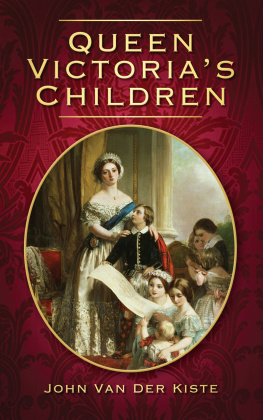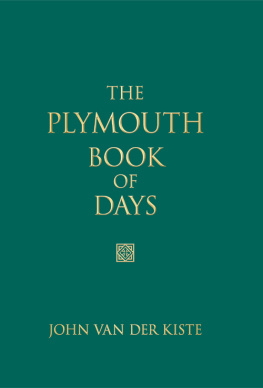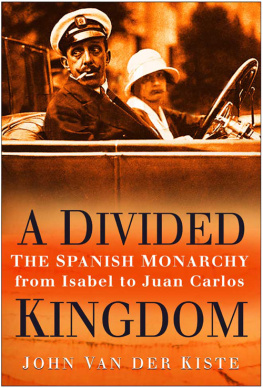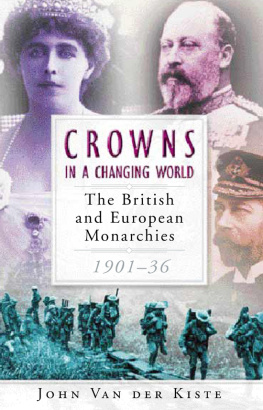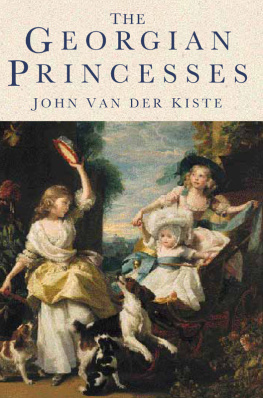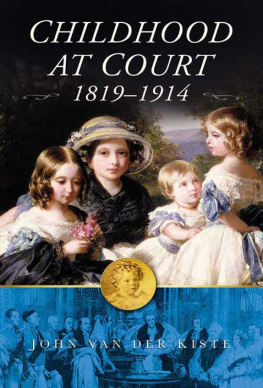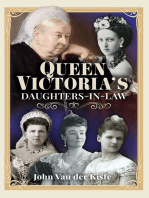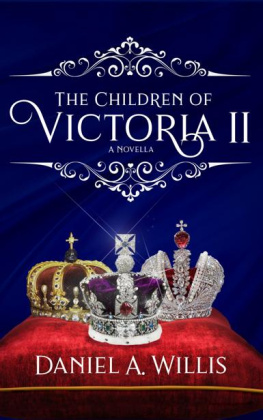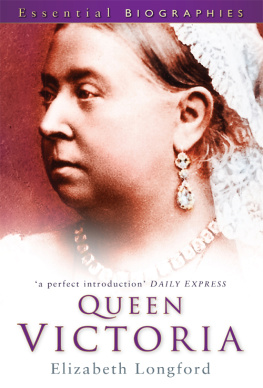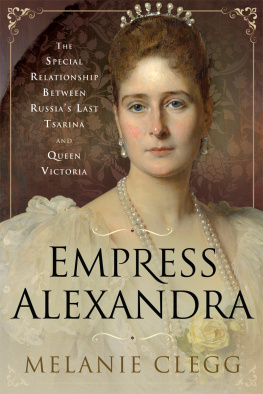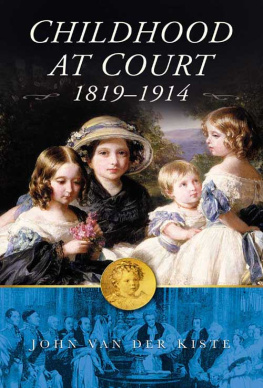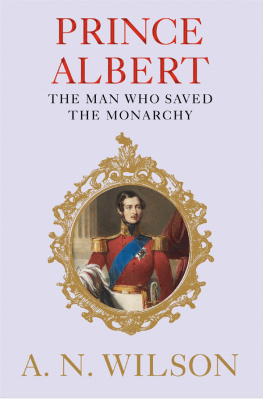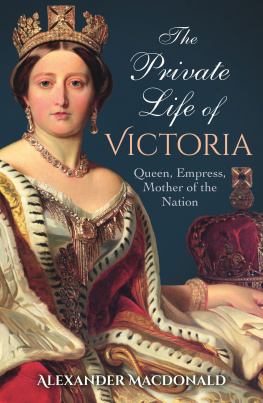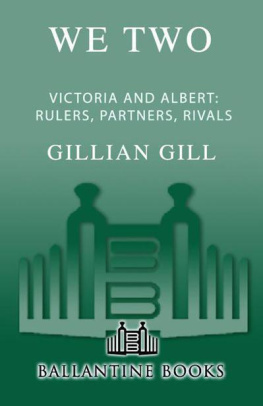QUEEN
VICTORIAS
CHILDREN
ALSO BY JOHN VAN DER KISTE
Frederick III (1981)
Dearest Affie [with Bee Jordaan] (1984)
Queen Victorias Children (1986)
Windsor and Habsburg (1987)
Edward VIIs Children (1989)
Princess Victoria Melita (1991)
George Vs Children (1991)
George IIIs Children (1992)
Crowns in a Changing World (1993)
Kings of the Hellenes (1994)
Childhood at Court 18191914 (1995)
Northern Crowns (1996)
King George II and Queen Caroline (1997)
The Romanovs 18181959 (1998)
Kaiser Wilhelm II (1999)
The Georgian Princesses (2000)
Gilbert & Sullivans Christmas (2000)
Dearest Vicky, Darling Fritz (2001)
Once a Grand Duchess [with Coryne Hall] (2002)
William and Mary (2003)
Emperor Francis Joseph (2005)
Sons, Servants and Statesmen (2006)
A Divided Kingdom (2007)
QUEEN
VICTORIAS
CHILDREN
JOHN VAN DER KISTE

Cover illustration: Queen Victoria and her Children by John Callcot Horsley
(18171903) (Forbes Magazine Collection/ The Bridgeman Art Library).
First published in 1986
This edition published 2009
The History Press
The Mill, Brimscombe Port
Stroud, Gloucestershire, GL5 2QG
www.thehistorypress.co.uk
This ebook edition first published in 2011
All rights reserved
John Van der Kiste, 1986, 2003, 2004, 2009, 2011
The right of John Van der Kiste, to be identified as the Author of this work has been asserted in accordance with the Copyrights, Designs and Patents Act 1988.
This ebook is copyright material and must not be copied, reproduced, transferred, distributed, leased, licensed or publicly performed or used in any way except as specifically permitted in writing by the publishers, as allowed under the terms and conditions under which it was purchased or as strictly permitted by applicable copyright law. Any unauthorised distribution or use of this text may be a direct infringement of the authors and publishers rights, and those responsible may be liable in law accordingly.
EPUB ISBN 978 0 7524 7324 6
MOBI ISBN 978 0 7524 7323 9
Original typesetting by The History Press
Contents
Preface to Second Edition
Q ueen Victorias Children was first published in 1986, and minor revisions were made to the first paperback edition in 1990. Since then our knowledge of Queen Victorias children has been added to immeasurably by further biographies and selections of letters. In addition to long-awaited comprehensive lives of Princess Louise, Prince Arthur and Prince Leopold, there has also been another major study of Princess Victoria, and the final volume in the series of letters between this eldest daughter and her mother. Add to these four major works on Queen Victoria herself, one taking the story up to 1861, the other three her complete life, and also a biography of her physician, Sir James Reid, and the sum total speaks for itself.
I have taken this opportunity to add to my text from these and other more recently published volumes, make a few small corrections, and undertake a thorough revision of the reference notes and bibliography.
In conclusion, I would like to dedicate this volume to Kim.
Foreword
Q ueen Victorias children have been the subject, individually and collectively, of substantial biographical attention. The two eldest, the Princess Royal (later the German Empress Frederick) and King Edward VII, have been dealt with adequately by several writers from personal and political angles, and most of the seven younger princes and princesses have been accorded at least one biography each. In addition there are various works on Queen Victorias family and children, even two on the Queen and her daughters.
Our knowledge of the children as individuals, however, is inevitably uneven. Queen Victoria and the Empress Frederick were among the most tireless correspondents and journal-writers of their time,* and it is largely thanks to the publication of so many of their letters that so much is known of their personalities, their likes and dislikes, their attitudes and relationships with the family. The Queens other children did not inherit these literary gifts in such measure. Moreover, some of them are known to have left instructions that much of their correspondence was to be burnt after their death. King Edward VII ordered the destruction of vast quantities of private letters from the Queen to Disraeli, describing her family; Princess Beatrice transcribed her mothers journals, destroying the original manuscript as she went along. Many more letters one can only guess at the quantity are still sealed at present and may be made available in future years.
Most of the Queens surviving correspondence has already been made available in some form, and the history of the family during her lifetime is thus reasonably well-documented. After 1901, the year in which she and the Empress Frederick died, there are still considerable gaps, and it is chiefly for this reason that Queen Victorias longest-lived children have been comparatively little written about. The aim of this book is to examine the relationships between her, her sons and her daughters, and between each other after her death, as clearly as available material will permit.
My thanks for help, advice and information are due to Theo Aronson; Bee Jordaan; John May; Shirley Stapley; and in particular my parents, Wing Commander Guy and Nancy Van der Kiste, for their assistance with reading the manuscript and checking proofs.
I am indebted to the following copyright holders for permission to quote from published works: Bell & Hyman Ltd (Dearest Child, Dearest Mama, Your Dear Letter, Darling Child, Beloved Mama, all edited by Roger Fulford); John Murray Ltd (King Edward the Seventh, by Philip Magnus; The letters of Queen Victoria); and Weidenfeld & Nicolson Ltd (Victoria R.I., by Elizabeth Longford; Victoria and her Daughters, by Nina Epton).
*When Conte Egon Caesar Corti was researching and writing his biography of the empress, an abridged English translation of which was published as The English Empress in 1957, he counted 4,161 letters from the empress to the Queen, in the Royal Archives at Windsor, and 3,777 from the Queen to her daughter, in the Kronberg Archives, all spanning the years 1858 to 1901.
Prologue
Q ueen Victorias grandparents, King George III and Queen Charlotte, had fifteen children, of whom twelve attained their majority. The five princesses were spinsters or childless. Of their seven brothers, only three were married in the eyes of the royal act of succession, passed by the King in 1772 as a safeguard against unsuitable alliances. Between them, they could only boast one legitimate or officially recognized grandchild Princess Charlotte of Wales, offspring of the tempestuous marriage of the Prince Regent and his wife Caroline.
In May 1816 Charlotte married the good-looking, earnest Prince Leopold of Saxe-Coburg Saalfeld. The match was popular, for Leopold made an agreeable change from his wifes ageing, dissolute uncles, but their happiness was destined to be tragically brief. Within eighteen months she gave birth to a stillborn son, and died herself.
Rarely had the country grieved so unanimously for a royal death. The large family of King George III, now a blind and deranged shadow, was apparently heading for extinction. There was no chance of the Prince Regent and his wife having further children, and the Dukes of York and Cumberland were validly married but still childless. Tempted by the prospect of generous parliamentary allowances in return for performing their dynastic duties, three of the other dukes were prepared to jettison their mistresses and seek suitable wives.

